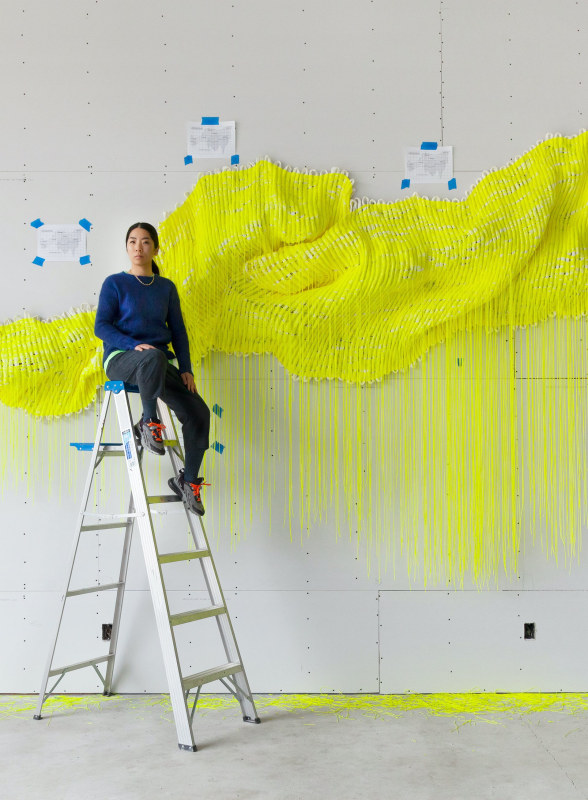Strand by Strand
Artist Mimi Jung on her latest, deeply personal projects—and making room to serve and breathe
Montana-based artist Mimi Jung is known for creating dreamy woven pieces that feel at once intimate and expansive, serenely still yet potentially kinetic. She experiments with new, intricate techniques while exploring deeply personal, broadly resonant experiences through her work—such as her time as a foster parent, which sparked not only the stunning Subsuming Ellipse series but also led her to launch, just this summer, a nation-wide arts program for teens in foster care.
A Brief Fall, Jung’s new, handwoven public installation in South Korea—Jung’s birthplace—is also particularly meaningful. It is the first public work for her in the country, and thus a sort of homecoming. It is the latest and arguably most ambitious work to-date in her ongoing Fallen Fence series, featuring cloud-like, topographical pieces that seemingly float and dance, mid-air. A Brief Fall is intended as a reminder of the beauty of unexpected moments, and our potential for connection—timely themes to be sure given all we’ve experienced over the past year and a half.
We spoke with Jung about these projects and more, from her new home in the idyllic Montana mountains.
Was there a particular moment when you realized you wanted to—and could—pursue a career in the arts?
Self-expression through visual art was very much part of my early education. My childhood days were mostly spent at my mother's art hagwon, attending gallery openings of her artist friends, and filling the time between creating various art projects for myself. We lived modestly; however, art supplies were always prioritized and plentiful. It was a given that I would pursue a career in a creative field. To this day, I'm still “creating various projects for myself,” just as I did as a child.
You studied fine art at Cooper Union in New York and graphic design in Switzerland. I understand fiber art came a bit later, after school, when you took a short weaving course and fell in love with it. I've heard you say elsewhere that now, nine or ten years later, it's “the only way I think.” I love that line; can you elaborate on that a bit?
I'm envious of fiber artists who had access to a broad education in weaving. Fiber art was not part of my studies at Cooper Union. However, my lack of formal training in weaving allows me to break quite a few rules to create my own language more freely.
When I say weaving is “the only way I think,” I mean I'm regularly investigating spaces through the presence of strands. So in a way, I'm also looking at forms as lines and spacing.
You consistently explore new techniques in your work, though each series takes two or three years to explore. Can you tell us a bit about some of the techniques you've investigated?
I'm interested in the growing and narrowing of space created by the proximity of the strands. With my latest Shield series, I've pushed the limitations of the grid format, breaking the conventions of the loom—creating impressions of movement within the composition. I am in the beginning stages of developing this series; it will undoubtedly branch out beyond the frame.
What about the pace of your work? It can take literally hundreds of hours to finish a single work, and then years to build a series. Is the process cathartic for you? And how do you approach work given that seemingly infinite time span for each piece?
Developing a series requires weaving a minimum of 100,000 yards. I often get asked, how long did this take you? My answer is that I try not to clock in the hours when working on a particular piece. I find calculating the time can sometimes feel disheartening.
I'm not a particularly patient person; weaving is one of the few exceptions to this behavior. My woven work requires great focus; the placement of each weft has a tolerance limit of a centimeter. It also demands relaxation of the body and a clear mind to achieve the desired gradual transformation of the composition. It's a delicate balance.

